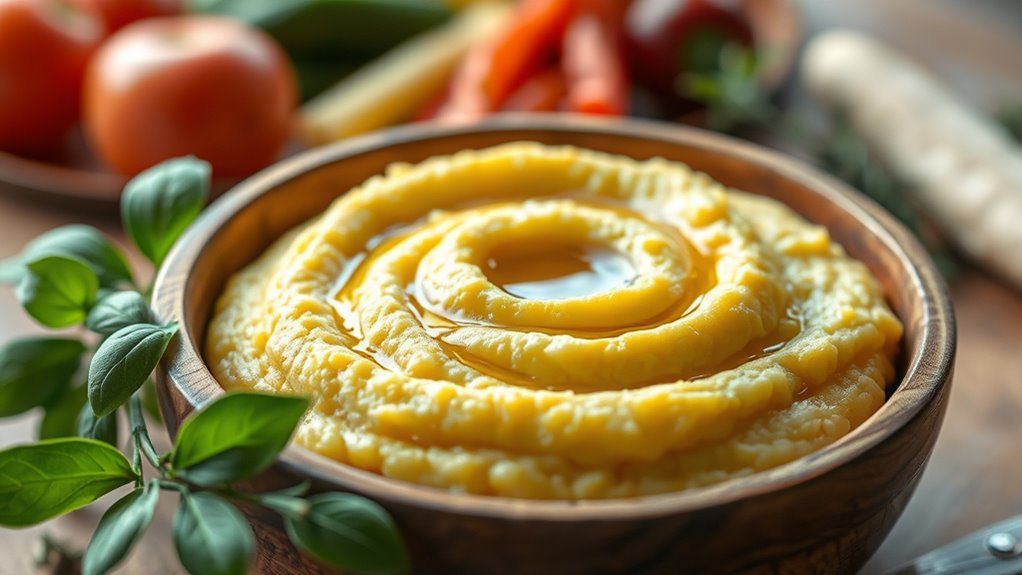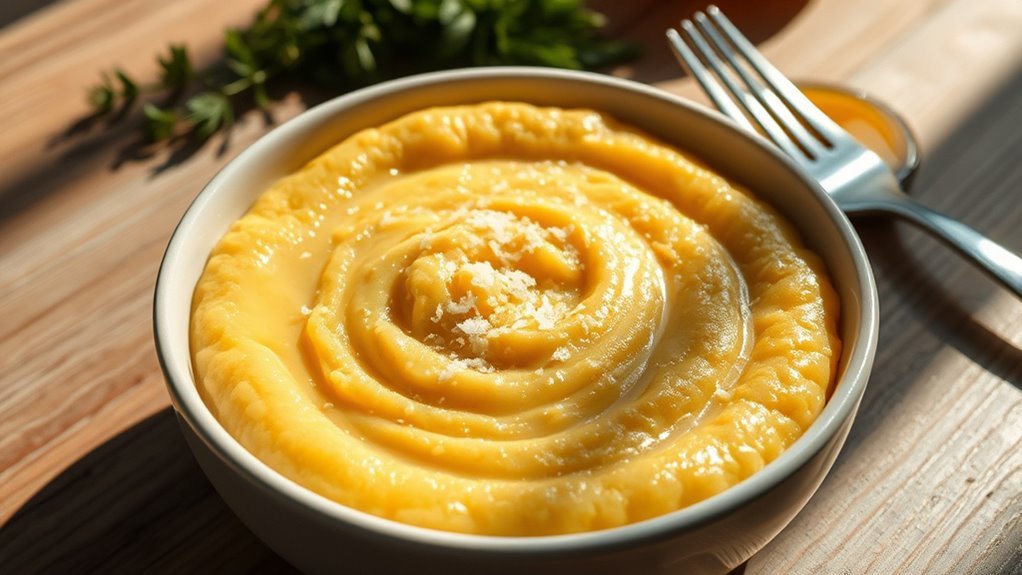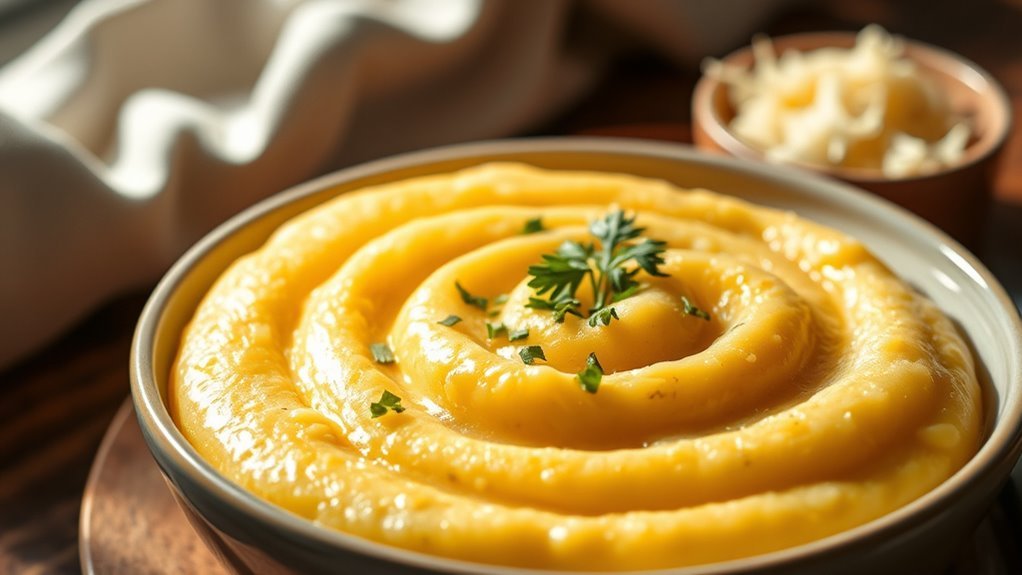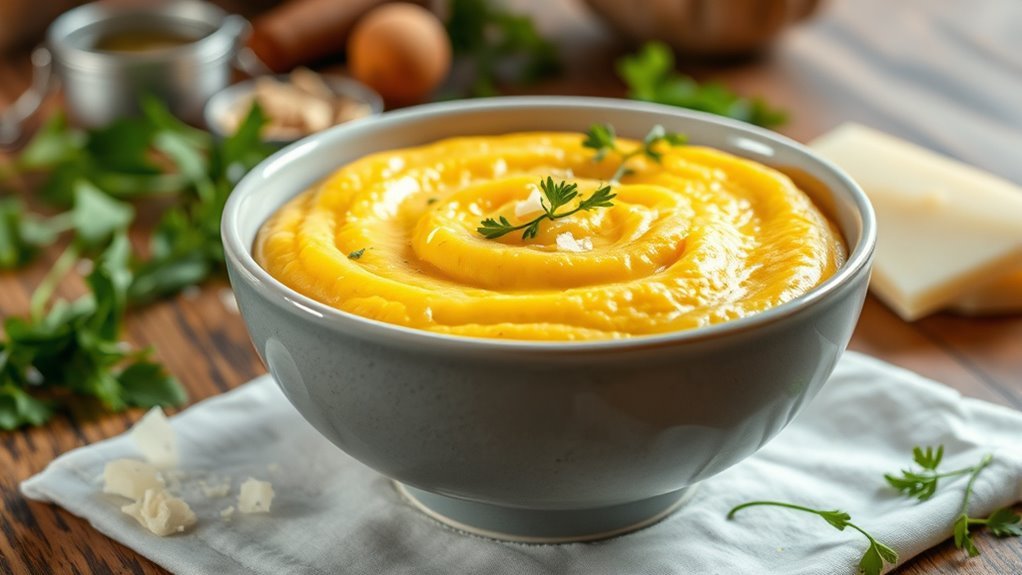Polenta isn’t typically considered keto-friendly due to its high carbohydrate content, with about 30 grams of carbs per cup. While it can provide essential nutrients and be enjoyed in moderation, it’s essential to monitor your carb intake if you’re following a ketogenic diet. It may fit into your meal plan if you balance it with low-carb ingredients. There’s more to learn about enjoying polenta while maintaining your keto goals, so keep exploring your options.
Understanding Polenta and Its Ingredients

Polenta, a traditional Italian dish made from ground cornmeal, serves as a versatile base for various meals. You can prepare it using different cooking methods, such as boiling, baking, or frying, each resulting in unique textures and flavor profiles. When boiled, polenta becomes creamy and smooth, perfect for pairing with rich sauces. Baking it creates a firmer texture, ideal for slicing. Frying gives it a crispy crust, adding a delightful contrast to its soft interior.
The flavor of polenta is naturally mild, allowing it to absorb spices, cheeses, and herbs, making it adaptable to a wide range of dishes. Whether you’re looking for comfort food or an elegant meal, polenta’s flexibility and ability to enhance flavors make it a beloved choice.
Nutritional Breakdown of Polenta

When considering the nutritional profile of this dish, it’s essential to recognize that polenta primarily consists of cornmeal, which is a source of carbohydrates. While its origins trace back to Northern Italy, polenta has become a beloved staple worldwide. The polenta benefits include being gluten-free and rich in essential nutrients like vitamin B6 and magnesium, which can support overall health. It also provides some fiber, promoting digestive health. However, it’s vital to balance these benefits with its carbohydrate content if you’re following specific dietary guidelines. Understanding these aspects helps you make informed choices about incorporating polenta into your meal plan while enjoying its unique texture and flavor.
Carbohydrate Content in Polenta

When considering polenta as a food option, it’s essential to look at its carbohydrate content, which can vary based on serving size. Typically, one cup of cooked polenta contains around 30 grams of carbohydrates, making it a significant source of carbs in your diet. By comparing this with other foods, you can better assess how polenta fits into your nutritional goals, especially on a keto diet.
Polenta Nutritional Overview
A closer look at the nutritional profile reveals that polenta primarily consists of carbohydrates, which is a key consideration for those following a keto diet. The texture of polenta can vary depending on the cooking method and the polenta varieties used, but its high carb content remains a constant. Here’s a brief overview of polenta’s nutritional makeup:
| Nutrient | Amount per 100g |
|---|---|
| Carbohydrates | 73g |
| Protein | 2.2g |
| Fat | 1.5g |
While polenta can be a delicious option for many dishes, if you’re aiming for a keto lifestyle, you’ll need to be mindful of its carb load. Balancing polenta with low-carb ingredients can help you enjoy its unique texture without straying from your dietary goals.
Carb Count Comparison
Although polenta is a beloved staple in many cuisines, its carbohydrate content can be a significant concern for those adhering to a keto diet. Typically, one cup of cooked polenta contains around 30 grams of carbs, which can quickly exceed keto guidelines that recommend limiting daily intake to about 20-50 grams. If you’re looking for alternative carb sources, consider options like cauliflower rice or zucchini noodles, which are lower in carbs and fit better within a keto framework. While polenta can be enjoyed occasionally, it’s essential to be mindful of portion sizes and overall carb intake to maintain ketosis. Balancing your meals with low-carb vegetables and healthy fats can help you stay on track while enjoying diverse flavors.
Serving Size Impact
Serving sizes play an essential role in determining the carbohydrate content of polenta. If you’re watching your carb intake, understanding portion control is vital. Here’s a quick look at the carbohydrate content based on different serving sizes:
| Serving Size (g) | Carbs (g) | Net Carbs (g) |
|---|---|---|
| 50 | 10 | 10 |
| 100 | 20 | 20 |
| 150 | 30 | 30 |
| 200 | 40 | 40 |
| 250 | 50 | 50 |
As you can see, the more polenta you serve, the higher the carb count. Keep these serving sizes in mind to maintain your keto goals while enjoying this versatile dish!
Comparing Polenta to Other Low-Carb Options
When considering low-carb options, how does polenta stack up against alternatives like cauliflower rice or zucchini noodles? Polenta, while higher in carbs, offers unique benefits like a rich source of vitamins and minerals. It can serve as a hearty base for meals, providing texture and flavor that might be missing from more traditional keto options. In contrast, cauliflower rice and zucchini noodles are markedly lower in carbs, making them more keto-compatible. However, they often lack the robust taste that polenta can bring to a dish. Ultimately, it’s about balance. If you choose to incorporate polenta, doing so in moderation could allow you to enjoy its benefits while still maintaining your low-carb goals.
Ways to Incorporate Polenta Into a Keto Diet
If you’re looking to incorporate polenta into a keto diet, exploring alternatives and creative recipes can help you stay on track. While traditional polenta may not fit the low-carb profile, options like cauliflower polenta can provide a similar texture with fewer carbs. Additionally, experimenting with different ingredients and cooking methods can lead to delicious, keto-friendly meals that satisfy your cravings.
Polenta Alternatives for Keto
Although polenta is often viewed as a comforting staple in many diets, its higher carbohydrate content can pose challenges for those following a keto lifestyle. Fortunately, there are several delicious alternatives to take into account. Cauliflower mash, for instance, offers a creamy consistency similar to polenta while being low in carbs and rich in nutrients. You can easily prepare it by steaming cauliflower and blending it with butter and seasoning. Another great option is zucchini noodles, which provide a versatile base for various sauces and toppings. Both alternatives can satisfy your cravings for comfort food without compromising your keto goals. By incorporating these substitutes, you can enjoy satisfying meals while maintaining a low-carb lifestyle.
Creative Polenta Recipes
While polenta may not be the best fit for a strict keto diet due to its carbohydrate content, there are creative ways to incorporate it in moderation. Try different polenta variations that can elevate your meals with savory toppings. Here’s a simple guide to inspire your culinary adventures:
| Polenta Variation | Savory Topping |
|---|---|
| Grilled Polenta | Mushroom Ragu |
| Baked Polenta Fries | Avocado Salsa |
| Creamy Polenta | Spinach & Feta |
| Polenta Cakes | Spicy Marinara Sauce |
These options let you enjoy the texture and taste of polenta while balancing your carb intake. Experiment with flavors and portion sizes to fit your keto lifestyle without sacrificing creativity or taste!
Potential Alternatives to Polenta for Keto Followers
As you explore keto-friendly options, there are several alternatives to polenta that can satisfy your craving for a hearty base without compromising your low-carb diet. One popular choice is cauliflower mash, which offers a creamy texture and can be seasoned to your liking. It’s low in carbs and high in nutrients, making it a nutritious substitute. Another great option is zucchini noodles, or “zoodles,” which provide a delightful, pasta-like experience without the carbs. They’re versatile and can be paired with various sauces and toppings. Both cauliflower mash and zucchini noodles can easily be incorporated into your meals, giving you freedom in your keto lifestyle while keeping your carb intake in check. Enjoy experimenting with these delicious alternatives!
Final Thoughts on Polenta and the Keto Lifestyle
When considering polenta in the context of a keto lifestyle, it’s crucial to weigh its nutritional profile against your dietary goals. While polenta does offer some health benefits, such as being a good source of vitamins and minerals, it’s primarily composed of carbohydrates. This high carb content can be a significant concern for those pursuing a strict ketogenic diet.
If you’re seeking to maintain ketosis, you might want to explore lower-carb alternatives. However, if you enjoy polenta and can fit it into your daily carb allowance, there’s no reason to eliminate it entirely. Ultimately, your dietary considerations should align with your personal health objectives, allowing you the freedom to enjoy a variety of foods while staying true to your keto lifestyle.
Frequently Asked Questions
Can I Eat Polenta on a Strict Keto Diet?
If you’re on a strict keto diet, eating polenta might feel like diving into a sea of carbs! With a high carb count, polenta isn’t the best choice for maintaining ketosis. Instead, consider keto alternatives like cauliflower rice or zucchini noodles. These options not only keep your carb intake low but also provide delicious, satisfying meals. Remember, the key is to stay informed and enjoy your freedom while sticking to your dietary goals.
What Are the Health Benefits of Polenta?
Polenta offers several health benefits thanks to its nutritional profile. It’s rich in carbohydrates, providing energy, and contains essential vitamins and minerals like vitamin A and iron. You’ll love its culinary versatility; it can be served creamy or allowed to set and sliced. Plus, it’s gluten-free, making it suitable for those with sensitivities. Including polenta in your meals can help diversify your diet while enjoying a hearty, comforting dish.
How Is Polenta Made From Corn?
Imagine golden kernels of corn dancing in the sunlight, waiting to transform into polenta. To make polenta, you start with corn grinding, finely milling dried corn into a coarse flour. Then, you boil water and gradually stir in the cornmeal, creating a creamy mixture. The polenta texture thickens as it cooks, becoming smooth and hearty. After simmering, you can serve it warm or let it cool for a versatile dish that’s both comforting and satisfying.
Is Polenta Gluten-Free?
Yes, polenta is gluten-free since it’s made from corn, making it a great option for those with gluten sensitivities. Its benefits include being rich in carbohydrates and providing essential nutrients like iron and vitamin B. If you’re looking for polenta alternatives, consider quinoa or rice for similar textures. Remember, incorporating a variety of grains can help diversify your diet while still enjoying the freedom of gluten-free choices!
Can Polenta Be Part of a Balanced Diet?
Imagine a canvas where vibrant flavors dance—polenta can certainly be part of that masterpiece called a balanced diet. With its rich polenta nutrition, it offers carbohydrates that fuel your energy. When paired with veggies and protein, it creates balanced meals that nourish both body and soul. Just remember, moderation is key. It’s about weaving diverse ingredients together, crafting a plate that delights your palate while keeping you energized and satisfied.


